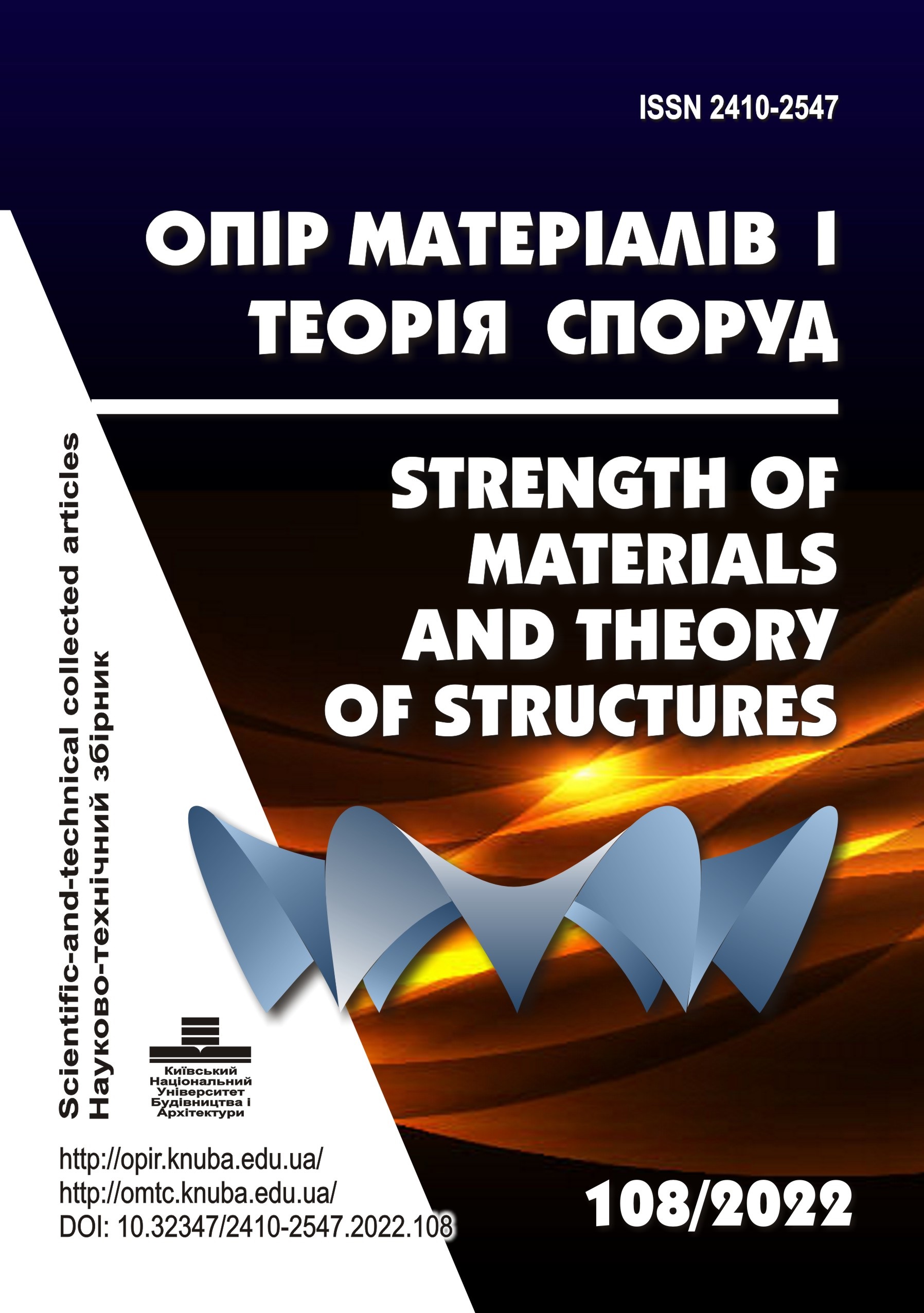The technology of crack repair by polymer composition
DOI:
https://doi.org/10.32347/2410-2547.2022.108.203-216Keywords:
reinforced concrete structures, cracks, polymer compositions, influence factors, soak technologyAbstract
Introduction. During the inspection of buildings and structures and development of design documentation for restoration works it was found that there is a need to provide recommendations or to develop solutions for repair work. These repair works either are not regulated by standards or may be technically or economically inefficient.
Problem Statement. The most common defect of the tension zone in reinforced concrete beams, floor slabs or roof slabs are cracks. Injection technology is normally used to repair it. However, in case of large number of small cracks, this technology is time consuming.
Purpose. Development of a new technology for repairing the tension zone of reinforced concrete beams, floor slabs or roof slabs with a large number of small cracks. This will ensure maximum filling of cracks with polymer compositions with their subsequent bonding.
Materials and methods. A number of factors that may affect the technology of filling cracks with polymer compositions have been identified from the analysis of scientific and technical literature. A special device ‘tray’ was produced for experimental research. It was attached to the lower zone by a system of ties or props. A repair mix to fill the cracks was fed into the tray under pressure. By means of changing the experiment conditions the strengthening level of previously destroyed samples were set.
Results. As a result, it was found that the maximum filling of cracks with the polymer composition is achieved within the 5-10 minutes of repair mix supply at a pressure in the system in the range of 0.5-0.6 atmospheres (atm). The maximum strengthening of the repaired structures under the re-applied destructive force was achieved at the conditions of repair work with a structural temperature of 20 ± 2 оС and dry state of the structure.
Conclusions. The technology of repair with polymer compositions of the cracks located on the lower surface of horizontal reinforced concrete structures has been developed. It was established that in the presence of small cracks on the structure (the width is up to 0.2 mm) the developed technology is most effective, in case of widths from 0.3 to 0.8 mm it is advisable to use injection technology whereas for widths larger than 0.8 mm the hybrid technology should be applied.
References
Chemrouk M. The deteriorations of reinforced concrete and the option of high performances reinforced concrete. The 5th International Conference of Euro Asia Civil Engineering Forum (EACEF-5). Procedia Engineering 125, 2015. Pp. 713–724. doi: 10.1016/j.proeng. 2015.11.112
Nepal J., Chen H. Assessment of concrete damage and strength degradation caused by reinforcement corrosion. Journal of Physics Conference Series, July 2015. No. 628 (1).
DOI: 10.1088/1742-6596/628/1/012050
Marder K., Sarrafzadeh M., Elwood K. Effectiveness of repair via epoxy injection of earthquake damaged reinforced concrete beam elements. 17th U.S.-Japan-New Zealand Workshop on the Improvement of Structural Engineering and Resilience. Р. 8.
Glewwe K. Full depth crack injection with concrete mender. 2017. https://concretemender.com/full-depth-crack-injection-with-concrete-mender/
Baldwin N., King E. Field studies of the effectiveness of concrete repairs. Phase 1 Report: Desk study and literature review. (Prepared by Mott MacDonald Ltd for the Health and Safety Executive 2003). Health and Safety Executive, 2003. 53 p. ISBN 0 7176 2783 7.
Aboalarab L. The Effect of Crack Opening Size and Repair Methods on Corrosion of Steel Reinforcement in Concrete. [Dissertation]. 2019. 200 р.
Srewil Y. Cracks of concrete and repair works & case study. Report number: Module G-4 Dresden Seminar, 2006. 12 р. DOI: 10.13140/RG.2.2.12299.95522
https://www.researchgate.net/publication/298178705_Cracks_of_concrete_and_repair_works_case_study
TU U 30553286.001-2000. Composite injection 'Consolid'. [Engineering specifications] (ukr)
Molodid O., Plokhuta R. Experimental researches of repair of cracks in reinforced concrete beams by soaking. Construction production. Kyiv: NDIBV, 2017. No. 63(1). Pр. 11–19. (ukr)
Molodid O., Plokhuta R., Kolesnikov V. Patent No. UA 114090, MPK E04B1/62 (2006.01). A method of repairing and protecting the horizontal reinforced concrete structures with a large number of small cracks by injection with a 'tray'. [Patent]. Kyiv, 2017. Bulletin No. № 4. 5 p. (ukr)
Molodid O., Plokhuta R. Experimental researches of technology of gluing the cracks in reinforced concrete structures by soaking. Modern technologies, materials and structures in construction. Vinnitsa, 2018. No. 25(2). Pp. 45–50. (ukr)
EN 1504. Product and system for the protection and repair of concrete structures – Definitions, requirements, quality, control and evaluation of conformity. [European Standard]. 2005. 214 p.
Molodid O., Plokhuta R. Research of the influence of technological factors on the quality indicators of repaired cracks in reinforced concrete slabs by soaking. East European Science Journal. Warsaw, 2019. No. 7(47). Pp. 59–66.
Molodid O., Plokhuta R. Technology of crack repair in reinforced concrete structures depending on the width. Ways to increase the efficiency of construction in the formation of market relations. Kyiv, 2019. No. 39(2). Pp. 154–162. (ukr)
TU U 30553286.003-2001. Epoxy glue 'Edmok'. [Engineering specifications]. (ukr)
DSTU B V.2.6-178:2011. Wall structures. Method for determining the strength of adhesion of facing tiles to the base. [Building codes]. Kyiv: NDIBV, 2012. 26 p. (ukr)
EN 1542:1999 Products and systems for the protection and repair of concrete structures. Test methods. Measurement of bond strength by pull-off. [European Standard]. 1999. 10 p.
I.N. Rudnieva. Сomparative analysis of strengthening of building structures (masonry, metal structures, reinforced concrete) using FRP-materials and traditional methods during reconstruction. «Strength of Materials and Theory of Structures», 2020. № 105 – C.267-291. https://doi.org/10.32347/2410-2547.2020.105.267-291
Rudnieva, Yu. Priadko, M. Priadko, H. Tonkacheiev. Osoblyvosti ta perspektyvy vykorystannia tekhnolohii pidsylennia budivelnykh konstruktsii kompozytsiinymy materialamy pry rekonstruktsii sporud. Zbirnyk naukovykh prats "BUDIVELNI KONSTRUKTsII. TEORIIa I PRAKTYKA". № 7 (2020), c.12-22. DOI: 10.32347/2522-4182.7.2020.12-22
Downloads
Published
Issue
Section
License

This work is licensed under a Creative Commons Attribution 4.0 International License.
Authors retain copyright and grant the journal right of first publication with the work simultaneously licensed under a Creative Commons Attribution License that allows others to share the work with an acknowledgement of the work's authorship and initial publication in this journal.

